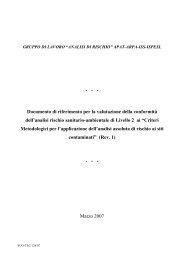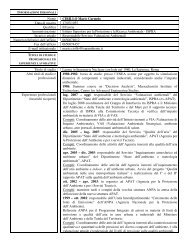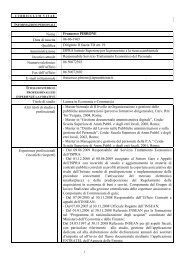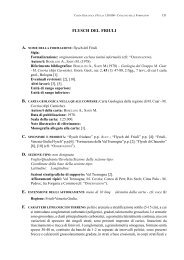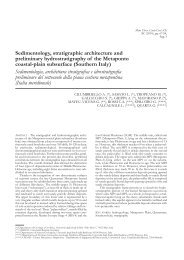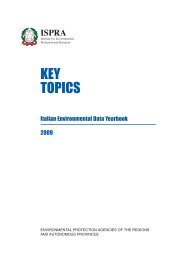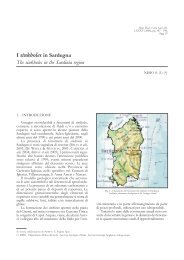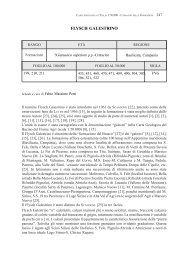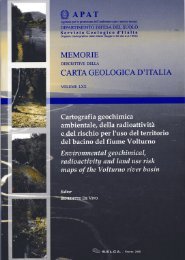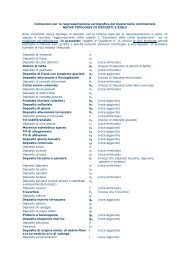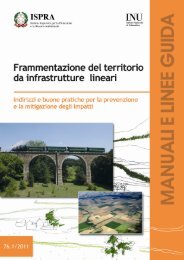Guidebook - Ispra
Guidebook - Ispra
Guidebook - Ispra
Create successful ePaper yourself
Turn your PDF publications into a flip-book with our unique Google optimized e-Paper software.
Volume n° 1 - from PR01 to B15<br />
B12<br />
B12 -<br />
Leader: M. Sandulescu<br />
section lineation: N53°E/ 36°SW). The regional trend<br />
of the stretching lineations marked by the elongation<br />
of the pebbles in the Laminated Conglomerates of the<br />
Arieșeni Nappe is also north-western, confirming the<br />
direction of the Alpine tectonic transport.<br />
The strain of the pebbles was exclusively an extensional<br />
one, as measurement of their shape has shown,<br />
the intensity of deformation being medium.<br />
Comparing the Es parameters for the pebbles of the<br />
Greenschist conglomerates with those of the Laminated<br />
Conglomerates in the Arieșeni Nappe, it may<br />
be concluded that the former were more intensely<br />
deformed (Es = 0.55 - 1.22 versus 0.55 - 0.80), having<br />
undergone an older Midcarboniferous tectonic phase<br />
that did not affect the latter. On Flinn’s diagram, the<br />
majority of the pebbles shows a k~1, the strain having<br />
been a plane one in the Laminated Conglomerates of<br />
the Arieșeni Nappe (Dimitrescu, 1995).<br />
Stop 5.10:<br />
Bubești Hill. Permian Vermicular<br />
Formation. Banatitic sill.<br />
At km 32 + 120 m, on the left slope of the valley<br />
above the road, the Permian is represented by red<br />
micaceous sandstones and argillaceous shales. In the<br />
sandstones, bioglyphs of burrow - fillings type can<br />
be observed. The Permian is pierced by a banatitic<br />
andesite sill.<br />
Stop 5.11:<br />
Piatra Muncelului. Lamprophyre dykes crossing<br />
Urgonian limestones.<br />
After reaching the main watershed of the Apuseni<br />
Mountains, the road leaves the Arieș hydrographic<br />
basin and enters the Crișul Negru basin, intersecting<br />
reddish Permian and quartzitic Lower Triassic<br />
formations.<br />
After a number of road windings and hair-pin bends<br />
across Lower Jurassic detrital formations changed<br />
into hornfelses (“Black Series”), a fault is traversed<br />
and then white massive limestones of Barremian in<br />
Urgonian facies belonging to the lowermost Bihor<br />
Unit are continuously exposed.<br />
At km 21 + 50 m, three almost vertical lamprophyre<br />
dykes striking about NS are intruded into the limestones.<br />
The thickness of the dykes ranges between<br />
1 and 3 m; the eastern one presents at its contact a<br />
breccia about 1 m thick, composed of angular fragments<br />
of white limestones (recrystallized as marbles)<br />
and of igneous rocks, enclosed in a calcareous-gritty<br />
cement.<br />
The lamprophyres correspond to odinites, consisting<br />
of basic plagioclase and augite, the ground-mass<br />
having an intergranular texture. It is worth noting the<br />
presence of pyroxenes as phenocrysts (Bleahu et al.,<br />
1981).<br />
Stop 5.12:<br />
Arieșeni - Băiţa road. Contacts Arieșeni<br />
Nappe / Următ Nappe / Bihor Unit.<br />
In the last outcrops of the limestones (km 20 + 60 m)<br />
numerous Coral traces as well as remnants of Megalodonts<br />
are to be observed; then, at the road surveyor’s<br />
cabin, the road crosses from the Bihor Unit into the<br />
Următ Nappe. The latter consists of slight micaceous<br />
shales, yellowish quartz sandstones and greyish calcarenites,<br />
all of them assigned to the Lower Jurassic.<br />
Further on, the road leads again into the Arieșeni<br />
Nappe consisting mainly of the Permian violaceous<br />
rocks. Red coloured rocks are gradually replaced<br />
by black coloured ones (“Black Series”) due to the<br />
thermal action of the banatitic body intruded here at a<br />
small depth (Bleahu et al., 1981).<br />
Stop 5.13:<br />
Băiţa Bihorului. Rhyolites in the black Permian.<br />
On entering the old mining locality of Băiţa Bihorului,<br />
opposite the first houses, on the right slope, a<br />
rhyolitic body is exposed. Its colour is light grey, due<br />
to thermal metamorphism with very slight violaceous<br />
hues at places. The rock presents a feebly pronounced<br />
foliation; the attitude of the layering is approximately<br />
N 20°E / 40°SE; two main joint systems are observable.<br />
The footwall consists of blackish vermicular<br />
micaceous sandstones, while in the hanging wall, the<br />
contact with black argillites and quartzites may be<br />
observed (“Black Series”).<br />
Past the town of Băiţa, on the right-hand side, the formation<br />
of the Bătrânescu Nappe appear contacting the<br />
Arieșeni Nappe along a fault. Skythian quartzites followed<br />
by dolomites and limestones of Middle Triassic<br />
age can be noticed. Finally the road reaches the Beiuș<br />
Depression with outcrops of Pliocene.<br />
Stop 5.14:<br />
Vașcău. Permian ignimbritic rhyolites.<br />
Ignimbritic rhyolites are exposed about 400 m west of<br />
the Vașcău railway station. White feldspar and quartz<br />
crystals about 1-3 mm in size are conspicuous, as well<br />
as leafy biotite, included in a greenish-grey schistose<br />
matrix. Characteristic “fiamme” are often noticed in<br />
the latter (N. Stan in Borcoș et al., 1980).



